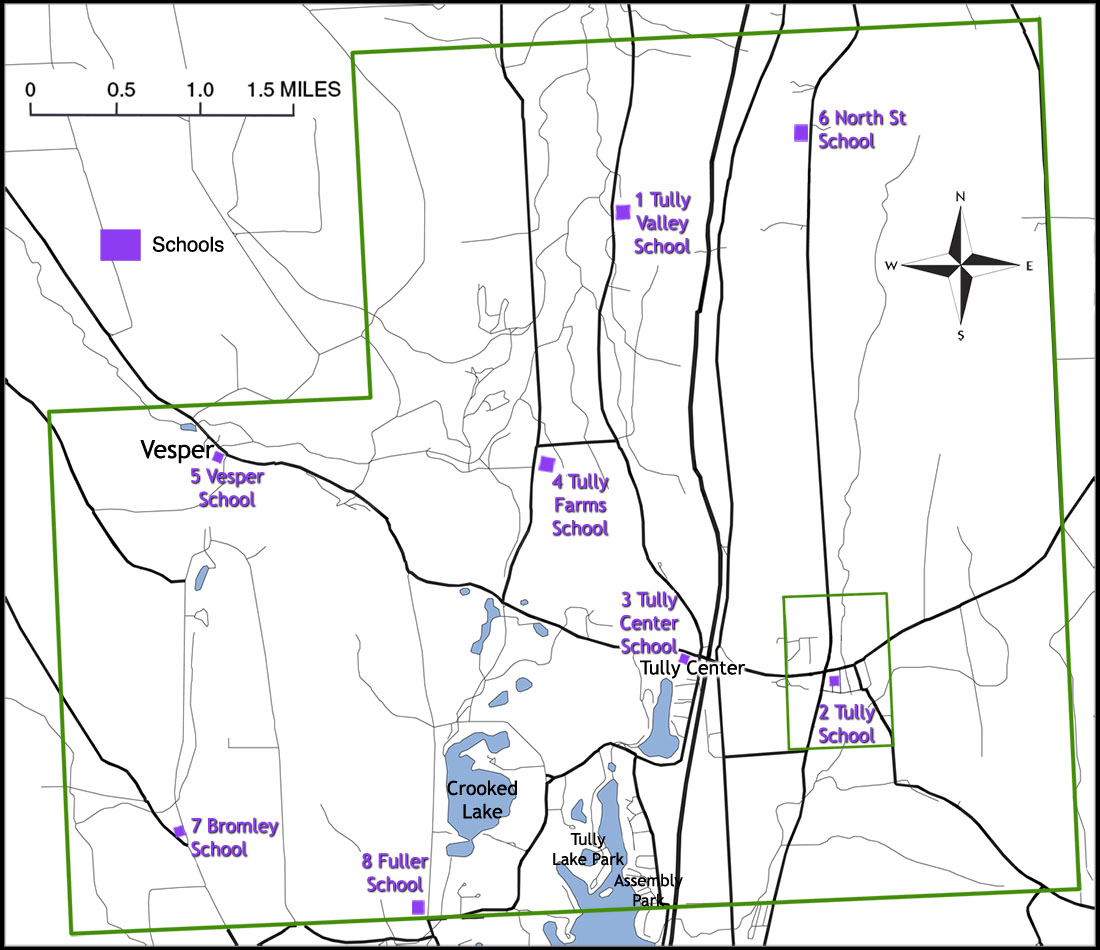A History of the Establishment of Schools in Tully
Quote from the Tully Times, August 19, 1893

"A good school is one of the grandest institutions a town can possess. It is the keystone of enlightenment and advancement."
History of the Schools in the Village of Tully
-
1801: Miss Ruth Thorpe established the first school in Timothy Walker's barn.
-
1804: A log schoolhouse was erected in the village.
-
1809: A frame schoolhouse was built to replace the log schoolhouse. This structure was destroyed by fire in 1823.
-
1823: The "Little Red Schoolhouse" (only 20x25 ft) was built on the same property as the present elementary school but was much closer to the road.
-
1848: A better school was built in place of the red schoolhouse. It was a 2-story frame building with one-story north and south wings
-
1880: The school built in 1848 was rebuilt and remodeled, becoming a large square building with 2 rooms downstairs and one large room upstairs.
-
1894: The common grade school was made the Tully Union School.
-
1895: A training school for teachers was established.
-
1898: The Tully Union School received a charter to add a high school accredited by the Board of Regents.
-
1901: An impressive 3-story red brick school building was built - one of the finest in central New York at that time.
-
1910: A course of study in Vocational Agriculture was added to the curriculum. It was the first of its kind in New York State.
-
1929: The school building that was built in 1901 was destroyed by flames. All records and equipment were lost. Little time was spent in mourning. Instead, the slogan became "Change calamity into opportunity."
-
1930: A new brick building was erected that served as both an elementary and a high school until 1970 (now the elementary school).
It was also at this time that the school became centralized and had 4 buses and 2 private vehicles pick up students from school districts in outlying areas.
-
1936: Kindergarten was added to the school.
-
1959: The Tully Central School was enlarged.
-
1970: A new Tully Central Junior-Senior High School building was opened.
About School Centralization
Before centralization in 1930, a "school district" was a single rural schoolhouse and each town numbered their schools/school districts.
Also before centralization, some students that lived in outlying areas traveled to the village of Tully to attend school there, even though it was not their school district. These students had to pay tuition. They would live with a local family for about 50¢ a week and were called "basket boarders" because they would arrive at the beginning of each week with a basket of provisions.
According to the Tully Independent of 11/8/1957, 25 school districts were eventually incorporated into the Tully Central School District. It took about 12 years, however, for all of these schools to join the centralization program.
The 25 schools that took part in the Tully School Centralization, along with their district numbers and the towns in which they were located, are listed here.
Eight schools in the Town of Tully:
Tully Valley, Tully Village, Tully Center, Tully Farms, Vesper, North St, Bromley, Fuller
Nine schools from the Town of Otisco:
Otisco, Octagon, Otisco, Dublin, Case Settlement, Otisco Center, Dutch Hill, Hallinan (or Woodmancy), Otisco Valley
Three from the Town of Preble:
Emmett Wells, Foley, Baltimore
Two from the Town of Fabius:
Apulia Station, Markham Hollow
One School from each of the towns of LaFayette, Spafford, and Truxton:
Ackles (LaFayette); Masters (Spafford); Eugene Wells (Truxton)

Information provided by the Tully Historical Society and Louise Lutz
|















